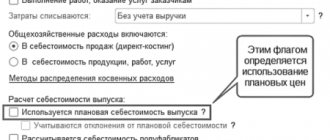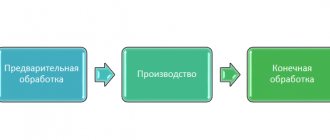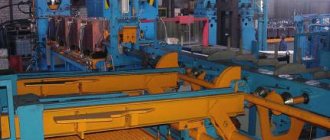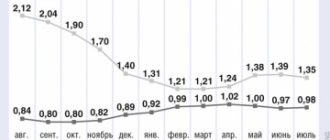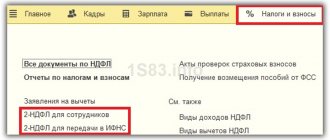Account 29 of accounting is an active account “Service production and facilities”, serves to summarize information on the costs of service production for the production of products, performance of work or provision of services, including costs on the balance sheet of the following types of activities:
- Department of Housing and Utilities;
- a consumer service workshop, for example, a sewing shop;
- dining room, buffet;
- preschool for children;
- sanatorium, holiday home, etc.
Account 29 in accounting
The costs of service production can be direct in direct activities and partially indirect in management and maintenance.
The debit of the account takes into account direct costs associated with the performance of work, production of products and provision of services, as well as the costs of auxiliary departments. The loan takes into account the actual cost of completed products, services provided or work performed. The account balance reflects the value of work in progress:
Analytical accounting for account 29 is carried out according to:
- to each service production:
- their cost items.
Possible correspondence
The activities of the service economy are a source of a huge amount of information, which is accumulated in position 29 of the Chart of Accounts. The designated position is active, i.e. its debit side reflects the expenses incurred related to the activities of these divisions, and the credit side reflects their write-off according to the relevant items.
During the reporting period, the specified account reflects the amounts of expenses that are written off at the end of the month. Its peculiarity is that it should take into account only direct costs that are directly related to the activities of service departments.
On the debit side, this position corresponds with such accounts as 02, 10, 23, 25, 60, 70.
When crediting this position, accounts such as 10, 25, 26, 29, 44, 90 are used.
Postings to account 29 “Service production and facilities”
Correspondence and main postings of account 29 are shown in the table below:
| Dt | CT | Wiring Description | A document base |
| 29 | 23 | Attribution of the cost of work/services of auxiliary production for servicing production facilities/farms | 301-APK, TTN, etc. |
| 29 | 28 | The cost of production includes losses from defects | Certificate of write-off of rejected products |
| 29 | 68 | Calculation of payments to road funds | Accounting information |
| 29 | 69 | Calculation of the unified social tax to the Social Insurance Fund, Pension Fund, etc. | T-49, Calculation of determining the share of the single tax, Accounting certificate |
| 29 | 70 | Calculation of wages to employees | T-49,136-APK, 137-APK, etc. |
| 29 | 71 | Payment of various expenses through accountable persons | AO-1 + documents for the purchase of MPZ |
| 29 | 73.03 | Write-off as expenses compensation for the use of personal cars of personnel for production needs | Agreement for the use of personal transport, Accounting certificate |
| 45 | 29 | Transfer of products to a third party | Acceptance certificate |
| 80 | 29 | The volume of work in progress was transferred to a friend | Partnership agreement |
| 97 | 29 | Costs are included in deferred expenses | Certificate of completion of work, TORG-12 |
| 29 | 11 | The cost of young animals for growing and fattening has been written off | Transfer and acceptance certificate, Invoice |
Typical accounting entries
If we look at typical accounting records, they will look like this:
1) Dt 29
Kt 28 – inclusion of losses from defects in the cost of manufactured goods;
2) Dt 29
Kt 71 – expenses of accountable persons employed in service businesses;
3) Dt 45
Kt 29 – transfer of products produced by the service department to third parties;
4) Dt 80
Kt 29 – transfer of work in progress to service facilities;
5) Dt 97
Kt 29 – costs of the designated division as part of deferred costs.
Examples of transactions and postings on account 29
Example 1. Provision of services to a third party
Let’s say Vesna LLC has a laundry on its balance sheet to provide paid services to third-party organizations. Based on the results of the reporting period:
- revenue - 11,800 rubles, VAT - 1,800 rubles;
- expenses – 4,500 rub.
In the accounting of Vesna LLC, the following entries are made to account 29 for the provision of services to third parties:
| Dt | CT | Transaction amount, rub. | Wiring Description | A document base |
| 29 | 10/70/69 | 4 500 | Laundry costs included | Certificate of completed work, Payroll |
| 62 | 90.01 | 11 800 | Revenue from the sale of services is taken into account | Agreement for the provision of laundry services |
| 90.02 | 29 | 4 500 | Expenses written off | Certificate of completed work, Payroll |
| 90.03 | 68 VAT | 1 800 | VAT accrued for payment to the budget | Invoice |
| 51 | 62 | 11 800 | Receipt of payment for services | Bank statement |
| 90.09 | 99 | 21 000 | Reflection of the financial result (profit) from sales at the end of the month | Certificate of completion of work, Accounting statement, SALT |
Example 2. Accounting for the costs of a preschool institution
Let’s say Vesna LLC has a kindergarten on its balance sheet. Based on the results of the reporting period:
- depreciation of equipment - 2,500 rubles;
- expenses for electricity and heat - 18,100 rubles, incl. VAT – 2,761 rubles;
- employee salary – 22,000 rubles;
- insurance premiums, including injuries – 7,900 rubles.
In the accounting of Vesna LLC, the following entries are made to account 29 to reflect the costs of the preschool institution:
| Dt | CT | Transaction amount, rub. | Wiring Description | A document base |
| 29 | 02 | 2 500 | Reflection of accrued depreciation | Depreciation statement |
| 29 | 60 | 18 100 | Expenses for heat and electricity are taken into account | Certificate of provision of services, Receipts for payment |
| 19 | 60 | 2 761 | VAT accepted for accounting | Invoice |
| 60 | 51 | 15 339 | Payment for services (heat and electricity) | Payment order |
| 68 VAT | 19 | 2 761 | Tax deduction | Invoice |
| 29 | 70 | 22 000 | Payroll for employees | Payroll |
| 29 | 69 | 7 900 | Calculation of insurance premiums |
Example of expense write-off
For example, Metallist LLC organizes meals for employees and third parties in its canteen. The canteen has its own equipment, that is, fixed assets. Staff are paid wages, food and materials are purchased. When preparing food, water and electricity are used. The division incurred expenses in the amount of 3,214,587 rubles for the month, including:
- Dt 29.3 Kt 02 “Depreciation of fixed assets” - 261,543 rubles;
- Dt 29.3 Kt 70 “Settlements with personnel for wages” - employee salaries in the amount of 325,000 rubles;
- Dt 29.3 Kt 69 “Calculations for social insurance and security” - 97,500 rubles at a rate of 30%;
- Dt 29.3 Kt 10 “Inventories” - 1,025,411 rubles;
- Dt 29.3 Kt 23 “Auxiliary production” - another division provided heat, water and heating in the amount of 157,000 rubles;
- Dt 29.3 Kt 41 “Goods” - food products were transferred to production in the amount of 1,348,133 rubles.
A profit of 4,118,000 rubles was received. It is necessary to record revenue and write off costs to cost of sales.
- Dt 62.01 Kt 90.01 - 4,118,000 rubles;
- Dt 90.03 Kt 68.02 - VAT charged on sales of 18% in the amount of 628,169.49 rubles;
- Dt 90.02 Kt 29.3 - costs written off for cost of 3,214,587 rubles;
- Dt 90.09 Kt 99.01 - profit of 903,413 rubles was taken into account.
Table 1. Analysis of account 29 for August 2021 Limited Liability Company "Metalist"
| Cor. Check | Debit | Credit | |
| Opening balance | |||
| 02 | 261.543,00 | ||
| 10 | 1.025.411,00 | ||
| 23 | 157.000,00 | ||
| 41 | 1.348.133,00 | ||
| 70 | 325.000,00 | ||
| 69 | 97500,00 | ||
| 90.02 | 3.217.587,00 | ||
| Turnover | 3.214.587,00 | 3.217.587,00 | |
| Closing balance | |||
Output data: BU (accounting data)
Case from practice
Let’s imagine a situation where a certain enterprise has on its balance sheet a children’s health camp for the children of employees. At the end of the reporting month, the camp incurred the following expenses:
- depreciation of operating systems and maintenance equipment was accrued - 2,837 rubles;
- utility costs amounted to 17,170 rubles, VAT amounted to 3,091 rubles;
- the salary for camp teachers was 23,730 rubles;
- the amount of insurance premiums is 6,747 rubles.
As a result, this enterprise made the following entries on the transactions performed:
Kt 02 – 2,837 rubles, depreciation;
Kt 60 – 14,079 rubles, utility costs;
Kt 60 – 3,091 rubles, the amount of VAT is reflected;
Kt 51 – RUB 17,170, transfer of funds to utility accounts;
Kt 19 – RUB 3,091, deduction of VAT;
Kt 70 – 23,730 rubles, wages of shift teachers;
Kt 69.1 – 6,747 rubles, insurance premiums.
Canteen of the enterprise. We organize accounting
Organization of accounting
If
the canteen of an enterprise serves only its employees
, accounting of business transactions related to its activities is kept on account 29 “Service industries and farms”.
In the debit of this account, all expenses directly related to the activities of the canteen are collected; in the credit, the actual cost of services provided is written off. If specialists eat for a fee, then accounting for income and expenses from paid services is organized on account 90 “Sales”. If lunches are provided free of charge, the cost of the services actually provided is written off to the debit of the cost accounts of those departments whose employees were provided with them (for example, to the debit of account 20 “Main production”). In a situation where a canteen provides services not only to its employees
, but also to outsiders, accounting is also kept on account 29. But only if the work of the canteen is not an independent type of activity of the organization. Otherwise, accounting for services must be organized according to the rules provided for public catering organizations. That is:
– the cost of dishes is formed on account 20 “Main production”. Moreover, only the products used in preparation are taken into account in this account; – food products are accounted for in account 41 “Goods” (products located in the canteen warehouse are accounted for in the subaccount “Goods in Warehouses”, and products in the buffet are accounted for in the subaccount “Goods in Retail Trade”); – other expenses (salaries, expenses for maintaining a canteen, etc.) are reflected in account 44 “Sales expenses”; – the financial result is revealed monthly on account 90 “Sales”. At the same time, if settlements with clients are made in cash, account 62 “Settlements with buyers and customers” may not be used. In this case, cash revenue can be recognized by direct posting to the debit of account 50 “Cash” and the credit of account 90 “Sales”.
Do I need to pay imputed tax?
Clause 2 of Article 346.26 of the Tax Code of the Russian Federation determines that business activities in relation to the provision of public catering services can be transferred to the payment of UTII. Under what circumstances does an organization need to do this?
POSITION OF THE RUSSIAN MINISTRY OF FINANCE
The opinion of specialists from the main financial department is clear: if all criteria established by law are met, the activities of the canteen should be transferred to UTII. Moreover, it does not matter whether it works only for the employees of the enterprise or whether other persons can also eat there. The Russian Ministry of Finance has the following arguments. If food services are provided for a fee, including by deducting it from earnings, then this activity is recognized as entrepreneurial (letter of the Ministry of Finance of Russia dated April 17, 2007 No. 03-11-04/3/118). Moreover, it is considered entrepreneurial even in the case when the organization receives a loss from the activities of the canteen. After all, as financiers noted in letter dated March 2, 2006 No. 03-11-04/3/101, the possibility of applying UTII does not depend on the amount of income received by the organization. The source (financing procedure) of income also does not affect. Therefore, even in a situation where an organization fully or partially pays employees for such meals, the activities of the canteen can be transferred to UTII (letter of the Ministry of Finance of Russia dated September 29, 2008 No. 03-11-04/3/446, dated December 19, 2007 No. 03-11-04/3/505). From the above, we can conclude that UTII must be paid for this activity regardless of whether: – whether employees bear the costs of paying for food services themselves or are paid by the employer; – whether the organization makes a profit from the activities of the canteen or not.
CRITERIA FOR APPLICATION OF UTII
In order to determine whether the activities of a canteen are subject to transfer to the payment of a single tax on imputed income, it is first necessary to clarify the area of the customer service hall. If it exceeds 150 sq. m, the question of applying “imputation” disappears automatically (subclause 8, clause 2, article 346.26 of the Tax Code of the Russian Federation). Organizations with an average number of more than 100 people are not entitled to apply UTII; – with a share of participation in the authorized capital of other organizations of more than 25 percent; – classified as the largest taxpayers. Such requirements are contained in paragraphs 2 and 2.1 of Article 346.26 of the Tax Code of the Russian Federation.
THE POINT OF VIEW OF THE OFFICIALS IS NOT INDIVIDUAL
There is also an alternative position. It is based on the fact that only those activities that are aimed at systematically generating profit should be considered entrepreneurial (Clause 1, Article 2 of the Civil Code of the Russian Federation). If an enterprise has opened a canteen only for its own employees, then we can say that its goal is to create more comfortable working conditions for specialists, to ensure the exercise of their rights to rest and food, which are provided for by labor legislation. Moreover, this is true not only when the canteen actually operates at a loss due to low prices, but also if the prices for food for employees still cover costs and allow them to make a profit. The above arguments are confirmed by the presence of extensive positive judicial practice - resolution of the FAS of the Ural District dated February 2, 2009 No. F09-36/09-S2, FAS of the North-Western District dated January 15, 2009 No. A05-5277/2008, the Presidium of the Supreme Arbitration Court of the Russian Federation dated February 13, 2007 No. 9565/06. Thus, an enterprise can help prove its rightness in not applying UTII by the fact that the enterprise’s obligation to provide workers with food was provided for by the collective agreement (Resolution of the Federal Antimonopoly Service of the Moscow District dated April 16, 2009 No. KA-A40/2929-09). And in the resolution of the Federal Antimonopoly Service of the Central District dated July 6, 2009 No. A62-6057/2008, the judges noted that the canteen was located in a closed guarded area, there was no access to it for third parties, and the lunches that were prepared in it were sold to employees without a trade markup . However, all these arguments are applicable only in the case where the canteen is organized exclusively for feeding the employees of the enterprise. The sale of prepared dishes to unauthorized persons still qualifies as a business activity in the provision of public catering services. And if the remaining conditions for the application of UTII by the organization are met, then it will be forced to switch to paying this tax.
Income tax
The procedure for recognizing such expenses in tax accounting directly depends on who the canteen operates for.
The canteen serves employees only.
In this case, there is no outsourcing of services. Therefore, it is not necessary to consider such a canteen an object of service industries and farms and apply Article 275.1 of the Tax Code of the Russian Federation. This was confirmed by the official bodies in letters from the Ministry of Finance of Russia dated April 17, 2007 No. 03-11-04/3/118 and the Federal Tax Service of Russia for Moscow dated January 15, 2008 No. 18-11 / [email protected] In this case all costs associated with maintaining the dining room premises (depreciation, repairs of premises, heating, water supply, electricity, etc.) must be included in other costs associated with production and sales.
The basis is subparagraph 48 of paragraph 1 of Article 264 of the Tax Code of the Russian Federation. Financiers also drew attention to this point in a letter dated September 16, 2009 No. 03-03-06/1/584. The salaries of full-time canteen workers should be taken into account in labor costs in accordance with Article 255 of the Tax Code of the Russian Federation (letter of the Ministry of Finance of Russia dated March 13, 2008 No. 03-03-06/1/173). Many arbitration judges agree with this approach (resolution of the FAS of the Volga Region dated October 28, 2008 No. A65-610/2007-SA2-22). Although there are still examples to the contrary (resolution of the Federal Antimonopoly Service of the Ural District dated October 22, 2008 No. F09-7611/08-S3). So, if tax accounting of expenses for maintaining a canteen is not carried out in the special order provided for in Article 275.1 of the Tax Code of the Russian Federation, the likelihood of a dispute with the tax authorities still remains. Outsiders may visit the dining room.
Tax accounting in such a situation is carried out according to the rules of Article 275.1 of the Tax Code of the Russian Federation (provided for service industries and farms). Namely, the tax base for the activities of the canteen is determined separately from the tax base for other types of activities (letters of the Ministry of Finance of Russia dated April 4, 2006 No. 03-03-04/1/318, dated November 13, 2007 No. 03-03-06/ 4/148). Moreover, if the canteen is unprofitable, it is possible to take into account losses (losses) only if three conditions are simultaneously met: - the cost of food in the canteen should be the same as in organizations that specialize in the field of public catering; – the costs of its maintenance should not exceed similar costs of catering enterprises; – the conditions for the provision of food services do not differ significantly from the conditions for the provision of services by organizations for which such activities are the main activity. If at least one of these conditions is not met (for example, lunches are sold without a markup), it is impossible to reduce the profit from the main activity by the loss received by the dining room. However, it can be carried forward for a period not exceeding 10 years and repaid only by future profits of the canteen. So, if when opening a canteen it is initially known that it will serve not only the employees of the enterprise, it makes sense to highlight the provision of catering services as one of the areas of business activity. That is, to give the canteen the status of not a service production, but one of the main productions.
To do this, these services should be recorded in the constituent and registration documents as among the usual activities of the enterprise, and canteens should also be formalized as independent structural units. With this option, accounting for income and expenses associated with the provision of food services is carried out in the generally established manner without applying Article 275.1 of the Tax Code of the Russian Federation.
The article was published in the journal “Accounting in Production” No. 4, April 2010.

